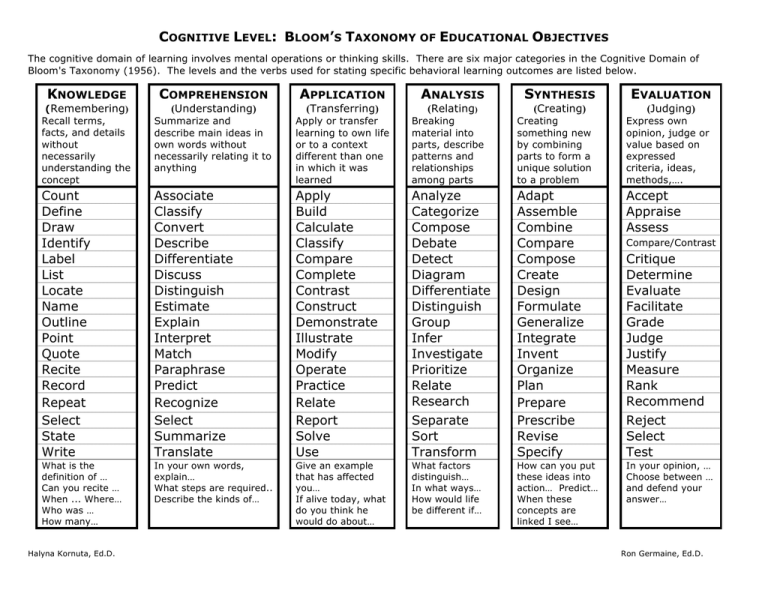Blooms Taxonomy of Educational Objectives One of the most widely used ways of organizing levels of expertise is according to Blooms Taxonomy of Educational Objectives3 Blooms. Blooms Taxonomy is a hierarchical model that categorizes learning objectives into varying levels of complexity from basic knowledge and comprehension to.

Blooms Taxonomy Taxonomy Education
Teachers rely on the taxonomy not only in the evaluative part of teaching but in.

. Spread the love This is a detailed guide to help draw out instructional goals created by Benjamin Bloom and his. Blooms taxonomy is a detailed classification of educational objectives. One of the most widely used ways of organizing levels of expertise is according to Blooms Taxonomy of Educational Objectives.
Blooms taxonomy of educational objectives is a hierarchical ordering of skills in different domains whose primary use is to help teachers teach and students learn. Knowledge this category includes the knowledge of specifics and the knowledge of means. Bloom et al 1994.
A statement of an objective contains a noun type of. Krathwohl 2002212 The original. It helps teachers determine which level every learner is on and assign them an individual task.
What is Blooms Taxonomy of Educational Objectives. Blooms taxonomy is a set of three hierarchical models used for classification of educational learning objectives into levels of complexity and specificity. Blooms Taxonomy is a popular framework used to formulate learning objectives in the learning and development and education sectors.
The three lists cover the learning objectives in cognitive affective and psychomotor domains. The cognitive domain list has been the primary focus of most traditional education and is frequently used to structure curriculum learning objectives assessments and activities. Blooms taxonomy allows educators to gauge the learners progress.
Blooms taxonomy of educational objectives This material is largely drawn from a handout from Dr Robert Kleinsasser School of Languages and Comparative Cultural Studies UQ. Together with Edward Gurst David Krathwohl Max Englehart and Walter Hill psychologist Benjamin Bloom released Taxonomy of Educational Objectives in 1956. By the use of taxonomy and analyses the teacher can state the educational objectives with g precision and.
This taxonomy included six main categories of objectives in the cognitive domain. The Taxonomy of Educational Objectives is a framework for classifying statements of what we expect or intend students to learn as a result of instruction. Nowadays though Blooms Taxonomy takes a deep effect on the educational process in K-12 institutions.
First introduced in 1956 by Benjamin. Course Objectives Blooms Taxonomy is a hierarchical classification of the different levels of thinking and should be applied when creating course objectives. BLOOMS TAXONOMY OF EDUCATIONAL OBJECTIVES Objectives state what we want our students to learn and be able to do.
Blooms Taxonomy of Educational Objectives 2 educators to design their lessons so that the students are doing more than just acquiring facts but are able to use those facts in a.

Bloom S Taxonomy Of Educational Objectives Creating Outcomes Using Bloom S Taxonomy Knowledge Management Blooms Taxonomy Taxonomy

Bloom S Taxonomy Deeper Learning How To Memorize Things Project Based Learning

Bloom S Taxonomy Taxonomy Guided Reading Lessons Kindergarten Blooms Taxonomy

Bloom S Taxonomy Of Educational Objectives Creating Outcomes Using Bloom S Taxonomy Knowledge Management Blooms Taxonomy Taxonomy
0 Comments